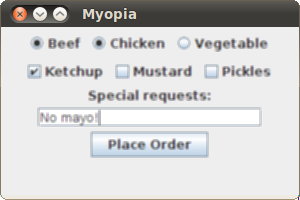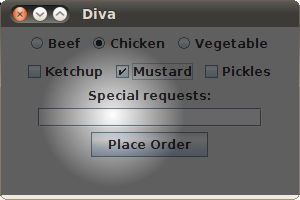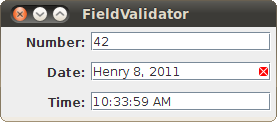How to Decorate Components with the JLayer Class
The JLayer class is a flexible and powerful decorator for Swing components. It enables you to draw on components and respond to component events without modifying the underlying component directly.
The JLayer class in Java SE 7 is similar in spirit to the
JxLayer project project at
java.net. The JLayer class was initially based on the JXLayer project, but its API evolved separately.
This document describes examples that show the power of the JLayer class. Full source code is available.
- Using the
JLayerClass - Using the
LayerUIClass - Drawing on Components
- Responding to Events
- Animating a Busy Indicator
- Validating Text Fields
For a brief introduction to the material on this page, watch the following video.
A JavaScript-enabled web browser and an Internet connection are required for the video. If you cannot see the video, try viewing it at YouTube.
Using the JLayer Class
The javax.swing.JLayer class is half of a team. The other half is the javax.swing.plaf.LayerUI class. Suppose you want to do some custom drawing atop a JButton object (decorate the JButton object). The component you want to decorate is the target.
- Create the target component.
- Create an instance of a
LayerUIsubclass to do the drawing. - Create a
JLayerobject that wraps the target and theLayerUIobject. - Use the
JLayerobject in your user interface just as you would use the target component.
For example, to add an instance of a JPanel subclass to a JFrame object, you would do something similar to this:
JFrame f = new JFrame(); JPanel panel = createPanel(); f.add (panel);
To decorate the JPanel object, do something similar to this instead:
JFrame f = new JFrame(); JPanel panel = createPanel(); LayerUI<JPanel> layerUI = new MyLayerUISubclass(); JLayer<JPanel> jlayer = new JLayer<JPanel>(panel, layerUI); f.add (jlayer);
Use generics to ensure that the JPanel object and the LayerUI object are for compatible types. In the previous example, both the JLayer object and the LayerUI object are used with the JPanel class.
The JLayer class is usually generified with the exact type of its view component, while the LayerUI class is designed to be used with JLayer classes of its generic parameter or any of its ancestors.
For example, a LayerUI<JComponent> object can be used with a JLayer<AbstractButton> object.
A LayerUI object is responsible for custom decoration and event handling for a JLayer object. When you create an instance of a LayerUI subclass, your custom behavior can be applicable to every JLayer object with an appropriate generic type. That is why the JLayer class is final; all custom behavior is encapsulated in your LayerUI subclass, so there is no need to make a JLayer subclass.
Using the LayerUI Class
The LayerUI class inherits most of its behavior from the ComponentUI class. Here are the most commonly overridden methods:
- The
paint(Graphics g, JComponent c)method is called when the target component needs to be drawn. To render the component in the same way that Swing renders it, call thesuper.paint(g, c)method. - The
installUI(JComponent c)method is called when an instance of yourLayerUIsubclass is associated with a component. Perform any necessary initializations here. The component that is passed in is the correspondingJLayerobject. Retrieve the target component with theJLayerclass'getView()method. - The
uninstallUI(JComponent c)method is called when an instance of yourLayerUIsubclass is no longer associated with the given component. Clean up here if necessary.
Drawing on Components
To use the JLayer class, you need a good LayerUI subclass. The simplest kinds of LayerUI classes change how components are drawn. Here is one, for example, that paints a transparent color gradient on a component.
class WallpaperLayerUI extends LayerUI<JComponent> {
@Override
public void paint(Graphics g, JComponent c) {
super.paint(g, c);
Graphics2D g2 = (Graphics2D) g.create();
int w = c.getWidth();
int h = c.getHeight();
g2.setComposite(AlphaComposite.getInstance(
AlphaComposite.SRC_OVER, .5f));
g2.setPaint(new GradientPaint(0, 0, Color.yellow, 0, h, Color.red));
g2.fillRect(0, 0, w, h);
g2.dispose();
}
}
The paint() method is where the custom drawing takes place. The call to the super.paint() method draws the contents of the JPanel object. After setting up a 50% transparent composite, the color gradient is drawn.
After the LayerUI subclass is defined, using it is simple. Here is some source code that uses the WallpaperLayerUI class:
import java.awt.*;
import javax.swing.*;
import javax.swing.plaf.LayerUI;
public class Wallpaper {
public static void main(String[] args) {
javax.swing.SwingUtilities.invokeLater(new Runnable() {
public void run() {
createUI();
}
});
}
public static void createUI() {
JFrame f = new JFrame("Wallpaper");
JPanel panel = createPanel();
LayerUI<JComponent> layerUI = new WallpaperLayerUI();
JLayer<JComponent> jlayer = new JLayer<JComponent>(panel, layerUI);
f.add (jlayer);
f.setSize(300, 200);
f.setDefaultCloseOperation (JFrame.EXIT_ON_CLOSE);
f.setLocationRelativeTo (null);
f.setVisible (true);
}
private static JPanel createPanel() {
JPanel p = new JPanel();
ButtonGroup entreeGroup = new ButtonGroup();
JRadioButton radioButton;
p.add(radioButton = new JRadioButton("Beef", true));
entreeGroup.add(radioButton);
p.add(radioButton = new JRadioButton("Chicken"));
entreeGroup.add(radioButton);
p.add(radioButton = new JRadioButton("Vegetable"));
entreeGroup.add(radioButton);
p.add(new JCheckBox("Ketchup"));
p.add(new JCheckBox("Mustard"));
p.add(new JCheckBox("Pickles"));
p.add(new JLabel("Special requests:"));
p.add(new JTextField(20));
JButton orderButton = new JButton("Place Order");
p.add(orderButton);
return p;
}
}
Here is the result:

Source code:
Run with Java Web Start:

The LayerUI class' paint() method gives you complete control over how a component is drawn. Here is another LayerUI subclass that shows how the entire contents of a panel can be modified using Java 2D image processing:
class BlurLayerUI extends LayerUI<JComponent> {
private BufferedImage mOffscreenImage;
private BufferedImageOp mOperation;
public BlurLayerUI() {
float ninth = 1.0f / 9.0f;
float[] blurKernel = {
ninth, ninth, ninth,
ninth, ninth, ninth,
ninth, ninth, ninth
};
mOperation = new ConvolveOp(
new Kernel(3, 3, blurKernel),
ConvolveOp.EDGE_NO_OP, null);
}
@Override
public void paint (Graphics g, JComponent c) {
int w = c.getWidth();
int h = c.getHeight();
if (w == 0 || h == 0) {
return;
}
// Only create the offscreen image if the one we have
// is the wrong size.
if (mOffscreenImage == null ||
mOffscreenImage.getWidth() != w ||
mOffscreenImage.getHeight() != h) {
mOffscreenImage = new BufferedImage(w, h, BufferedImage.TYPE_INT_RGB);
}
Graphics2D ig2 = mOffscreenImage.createGraphics();
ig2.setClip(g.getClip());
super.paint(ig2, c);
ig2.dispose();
Graphics2D g2 = (Graphics2D)g;
g2.drawImage(mOffscreenImage, mOperation, 0, 0);
}
}
In the paint() method, the panel is rendered into an offscreen image. The offscreen image is processed with a convolution operator, then drawn to the screen.
The entire user interface is still live, just blurry:

Source code:
Run with Java Web Start:

Responding to Events
Your LayerUI subclass can also receive all of the events of its corresponding component. However, the JLayer instance must register its interest in specific types of events. This happens with the JLayer class' setLayerEventMask() method. Typically, however, this call is made from initialization performed in the LayerUI class' installUI() method.
For example, the following excerpt shows a portion of a LayerUI subclass that registers to receive mouse and mouse motion events.
public void installUI(JComponent c) {
super.installUI(c);
JLayer jlayer = (JLayer)c;
jlayer.setLayerEventMask(
AWTEvent.MOUSE_EVENT_MASK |
AWTEvent.MOUSE_MOTION_EVENT_MASK
);
}
All events going to your JLayer subclass get routed to an event handler method whose name matches the event type. For example, you can respond to mouse and mouse motion events by overriding corresponding methods:
protected void processMouseEvent(MouseEvent e, JLayer l) {
// ...
}
protected void processMouseMotionEvent(MouseEvent e, JLayer l) {
// ...
}
The following is a LayerUI subclass that draws a translucent circle wherever the mouse moves inside a panel.
class SpotlightLayerUI extends LayerUI<JPanel> {
private boolean mActive;
private int mX, mY;
@Override
public void installUI(JComponent c) {
super.installUI(c);
JLayer jlayer = (JLayer)c;
jlayer.setLayerEventMask(
AWTEvent.MOUSE_EVENT_MASK |
AWTEvent.MOUSE_MOTION_EVENT_MASK
);
}
@Override
public void uninstallUI(JComponent c) {
JLayer jlayer = (JLayer)c;
jlayer.setLayerEventMask(0);
super.uninstallUI(c);
}
@Override
public void paint (Graphics g, JComponent c) {
Graphics2D g2 = (Graphics2D)g.create();
// Paint the view.
super.paint (g2, c);
if (mActive) {
// Create a radial gradient, transparent in the middle.
java.awt.geom.Point2D center = new java.awt.geom.Point2D.Float(mX, mY);
float radius = 72;
float[] dist = {0.0f, 1.0f};
Color[] colors = {new Color(0.0f, 0.0f, 0.0f, 0.0f), Color.BLACK};
RadialGradientPaint p =
new RadialGradientPaint(center, radius, dist, colors);
g2.setPaint(p);
g2.setComposite(AlphaComposite.getInstance(
AlphaComposite.SRC_OVER, .6f));
g2.fillRect(0, 0, c.getWidth(), c.getHeight());
}
g2.dispose();
}
@Override
protected void processMouseEvent(MouseEvent e, JLayer l) {
if (e.getID() == MouseEvent.MOUSE_ENTERED) mActive = true;
if (e.getID() == MouseEvent.MOUSE_EXITED) mActive = false;
l.repaint();
}
@Override
protected void processMouseMotionEvent(MouseEvent e, JLayer l) {
Point p = SwingUtilities.convertPoint(e.getComponent(), e.getPoint(), l);
mX = p.x;
mY = p.y;
l.repaint();
}
}
The mActive variable indicates whether or not the mouse is inside the coordinates of the panel. In the installUI() method, the setLayerEventMask() method is called to indicate the LayerUI subclass' interest in receiving mouse and mouse motion events.
In the processMouseEvent() method, the mActive flag is set depending on the position of the mouse. In the processMouseMotionEvent() method, the coordinates of the mouse movement are stored in the mX and mY member variables so that they can be used later in the paint() method.
The paint() method shows the default appearance of the panel, then overlays a radial gradient for a spotlight effect:

Source code:
Run with Java Web Start:

Animating a Busy Indicator
This example is an animated busy indicator. It demonstrates animation in a LayerUI subclass and features a fade-in and fade-out. It is more complicated that the previous examples, but it is based on the same principle of defining a paint() method for custom drawing.
Click the Place Order button to see the busy indicator for 4 seconds. Notice how the panel is grayed out and the indicator spins. The elements of the indicator have varying levels of transparency.
The LayerUI subclass, the WaitLayerUI class, shows how to fire property change events to update the component. The WaitLayerUI class uses a Timer object to update its state 24 times a second. This happens in the timer's target method, the actionPerformed() method.
The actionPerformed() method uses the firePropertyChange() method to indicate that the internal state was updated. This triggers a call to the applyPropertyChange() method, which repaints the JLayer object:

Source code:
Run with Java Web Start:

Validating Text Fields
The final example in this document shows how the JLayer class can be used to decorate text fields to show if they contain valid data. While the other examples use the JLayer class to wrap panels or general components, this example shows how to wrap a JFormattedTextField component specifically. It also demonstrates that a single LayerUI subclass implementation can be used for multiple JLayer instances.
The JLayer class is used to provide a visual indication for fields that have invalid data. When the ValidationLayerUI class paints the text field, it draws a red X if the field contents cannot be parsed. Here is an example:

Source code:
Run with Java Web Start:

